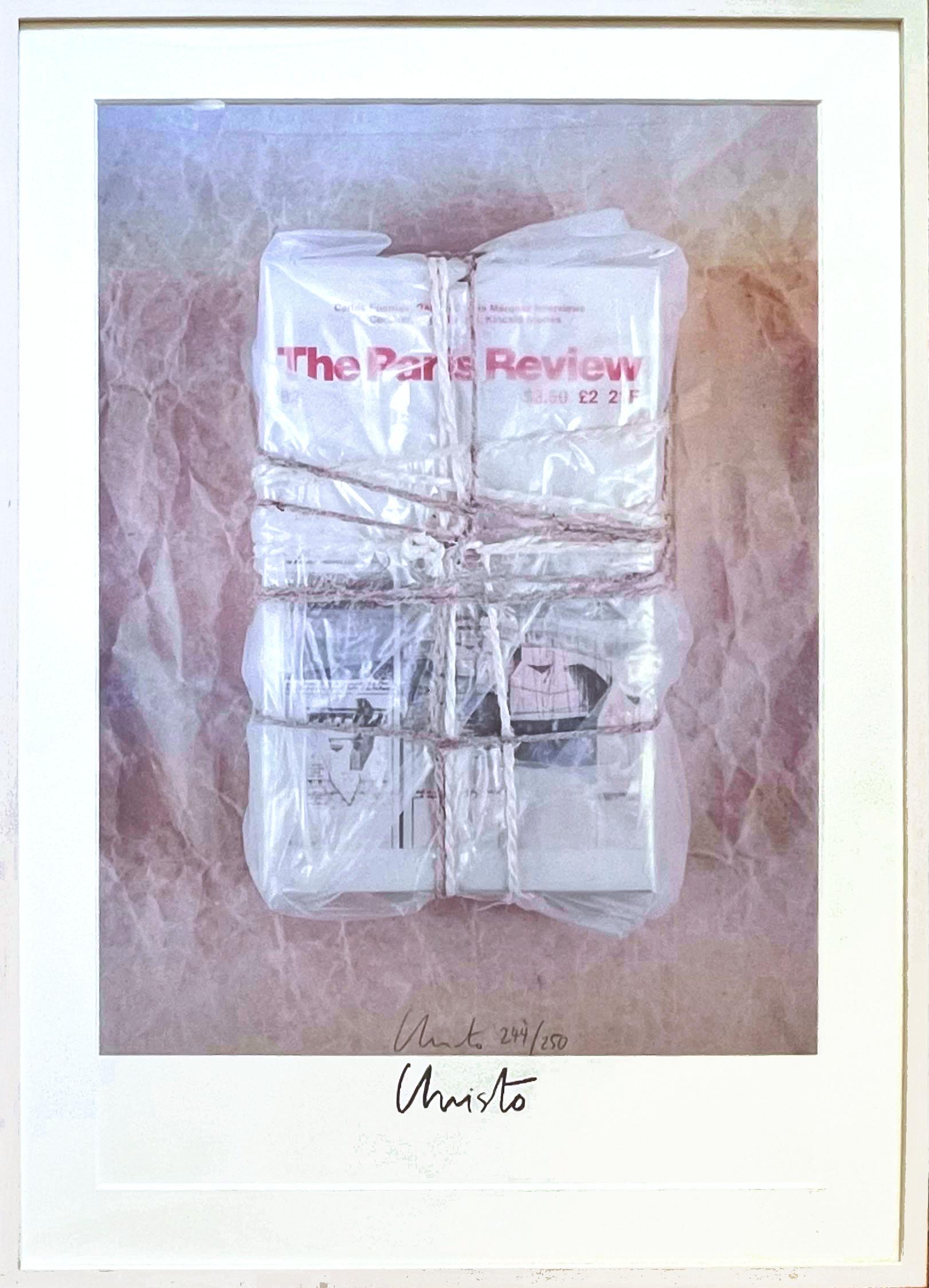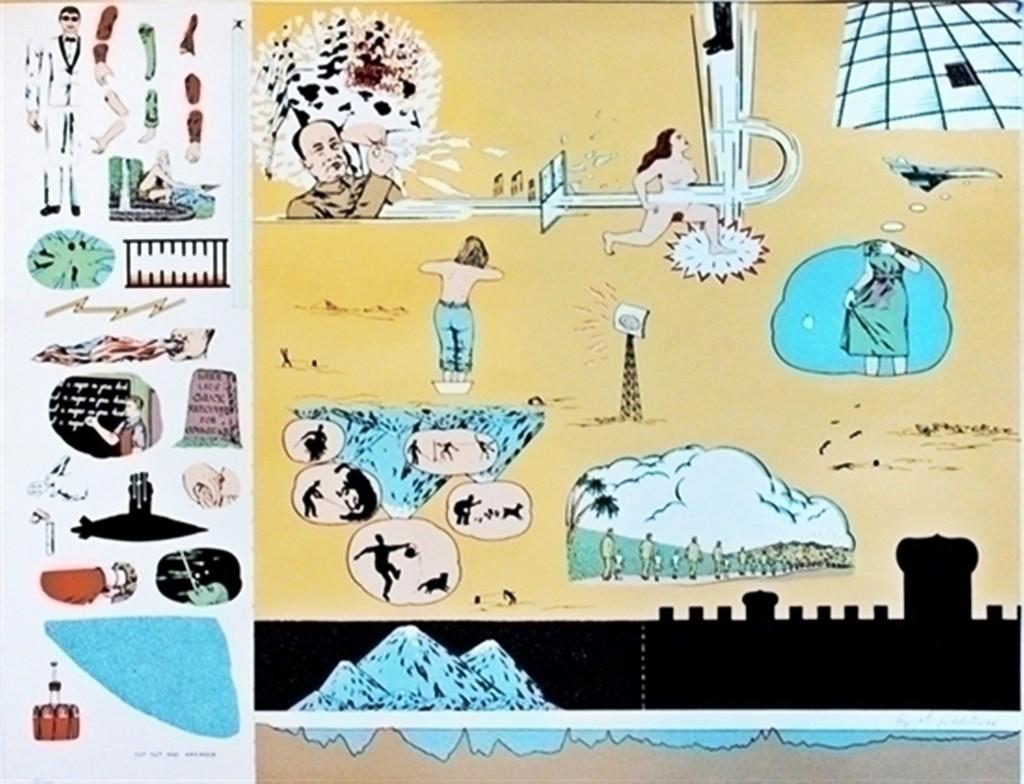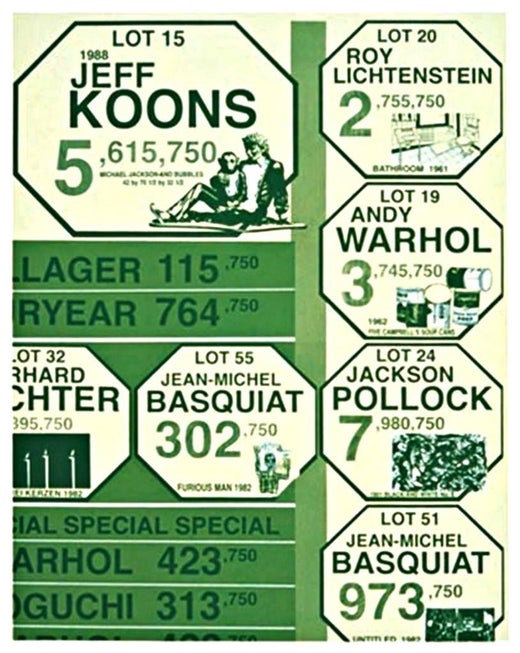Kerry James MarshallMay 15 2001, signed silkscreen cultural commentary famed African American artist2003
2003
About the Item
- Creator:Kerry James Marshall (1955, American)
- Creation Year:2003
- Dimensions:Height: 30.5 in (77.47 cm)Width: 25.5 in (64.77 cm)Depth: 1.25 in (3.18 cm)
- Medium:
- Movement & Style:
- Period:
- Condition:Not examined outside of original vintage wood frame, but appears to be in excellent condition. (frames not guaranteed).
- Gallery Location:New York, NY
- Reference Number:1stDibs: LU1745214454642
Kerry James Marshall
In his multifaceted work, Kerry James Marshall strives to address “the lack in the image bank” by elevating Black figures who have been excluded from Western art. Using a variety of black pigments, the artist heightens the skin tones of his subjects to honor their identities rather than ignore them. Best known for his large-scale paintings, Marshall also works in collage, photography, video and other media.
Born in Birmingham, Alabama, Marshall later grew up in the Watts neighborhood of Los Angeles, where his family relocated in 1963. As he studied art, including at the Otis Art Institute (now Otis College of Art and Design) in Los Angeles, he was struck by the absence of Black bodies in art history and museums. At the age of 25, he painted A Portrait of the Artist as a Shadow of His Former Self (1980). Its central figure, whose features almost merge with the background in their varying shades of black, references Ralph Ellison’s Invisible Man, the protagonist of which cannot be seen as a human being by other members of society because he is Black. For Marshall, A Portrait marked the start of an ongoing examination of the simultaneous visibility and invisibility of Black Americans.
Marshall’s practice has continued to concentrate on confronting stereotypes in the Black experience by celebrating joy and commemorating moments of Black history. His paintings frequently engage with the white-dominated traditions of the art historical canon by borrowing elements of style ranging from the Renaissance to the abstract movements of the 20th century. While he has said that he is driven by a sense of social responsibility for what he witnessed growing up in the South before the Civil Rights Act and in Los Angeles during the Watts riots of 1965, Marshall doesn’t focus on trauma in his works’ narrative scenes. Instead, they regularly depict people involved in everyday activities yet portrayed with the monumentality of a tableau painting.
Now based in Chicago, Marshall is recognized as one of the country’s leading contemporary painters, with a 2016 retrospective, "Mastry," touring the MCA Chicago, MOCA and the Metropolitan Museum of Art. In 2018, his painting Marshall’s Past Times (1997) sold for $21.1 million, the highest ever auction price for a work by a living Black artist.
Browse a collection of Kerry James Marshall’s art on 1stDibs.
- ShippingRetrieving quote...Ships From: New York, NY
- Return PolicyA return for this item may be initiated within 1 day of delivery.
- Eddie (Sylvie's Brother) in the Desert (celebrated 1960s silkscreen) Signed/NBy Oyvind FahlstromLocated in New York, NYÖyvind Fahlström Eddie (Sylvie's Brother) in the Desert (from New York International Portfolio), 1966 Silkscreen on wove paper Pencil signed and numbered from the limited edition of ...Category
1960s Pop Art Abstract Prints
MaterialsScreen, Pencil, Graphite
- Santa Fe Opera (Deluxe VIP Edition; Hand Signed & Numbered AP Edition of 50)By Robert IndianaLocated in New York, NYROBERT INDIANA Santa Fe Opera (Hand signed, numbered), 1976 Silkscreen on wove paper 37 1/2 × 27 inches Edition AP 7/50 Hand Signed and dated lower rig...Category
1970s Pop Art Abstract Prints
MaterialsScreen, Pencil, Graphite
- Thou Shalt Have No Other Gods Before Me (The First Commandment)By Kenny ScharfLocated in New York, NYKenny Scharf Thou Shalt Have No Other Gods Before Me (The First Commandment), 1987 5-Color lithograph on Dieu Donne handmade paper with deckled edges 24 × 18 inches Hand signed, date...Category
1980s Pop Art Abstract Prints
MaterialsLithograph, Pencil, Graphite
- Fun Vacation (200, Engberg) (Hand signed 13/16 by Ed Ruscha AND Kenny Scharf)Located in New York, NYEd Ruscha and Kenny Scharf Fun Vacation (200, Engberg), 1990 Lithograph in five colors on white Rives BFK paper (hand signed by BOTH Ed Ruscha and Kenny Scharf) 36 × 27 inches Hand-s...Category
1990s Pop Art Abstract Prints
MaterialsPencil, Graphite, Lithograph
- Femme de Peuple II (hand signed and inscribed to poet Robert Duncan)By R.B. KitajLocated in New York, NYR. B. Kitaj Femme de Peuple II (hand signed and inscribed to poet Robert Duncan), 1978 Offset Lithograph (hand signed and inscribed to poet Robert Duncan) Hand signed and inscribed o...Category
1970s Pop Art Figurative Prints
MaterialsGraphite, Offset, Lithograph
- Wrapped Paris Review deluxe hand signed, numbered Lt Ed for literary publicationBy ChristoLocated in New York, NYChristo Wrapped Paris Review (Deluxe hand signed edition), 1982 Lithograph and offset lithograph Hand signed and numbered 244/250 by Christo on th...Category
1980s Pop Art Abstract Prints
MaterialsLithograph, Offset, Graphite, Pencil
- Study of HandsBy Roy LichtensteinLocated in New York, NYCreated in 1981 as an original lithograph with screen-printing, Roy Lichtenstein’s, Study of Hands is hand-signed in pencil, dated and numbered, measuring 31 ¼ x 32 ¾ in. (79.5 x 83....Category
20th Century Pop Art Figurative Prints
MaterialsLithograph, Screen
- FOR THE YOUNG ARTISTBy James RosenquistLocated in Aventura, FLScreen print in colors on wove paper. Hand signed, dated, numbered and titled by James Rosenquist. Edition 65/80. Artwork size 35 x 36 inches. Frame size approc 39 x 40 inches. Near the top of the dot filled image hangs the outline of a light bulb followed by a series of letters numbers and symbols: ICU2RA Star (symbol). Decoded: I see you too are a star. Artwork is in excellent condition. Certificate of authenticity included. All reasonable offers will be considered. About the Artist: James Rosenquist (American, 1933–2017) was an artist known for his monumental paintings and prints. Often appropriating commercial imagery, his montage-like works combined popular culture, Surrealism, and historical painting methods. “Much of the aesthetic of my work comes from doing commercial art,” the artist once said. “I painted pieces of bread, Arrow shirts, movie stars. It was very interesting. Before I came to New York I wanted to paint the Sistine Chapel. I thought this is where the school of mural painting exists.” In his politically charged multi-panel painting F-111 (1964–1965), the artist offered a visual critique of the Vietnam War, with a medley of mushroom clouds, advertising, and populist imagery. Born on November 29, 1933 in Grand Forks, ND, Rosenquist went on to attend the University of Minnesota, before studying at the Art Students League in New York under George Grosz, Morris Kantor, and Edwin Dickinson...Category
1990s Pop Art Abstract Prints
MaterialsPaper, Screen
- Joe Tilson British Pop Art Screenprint, Color Lithograph 4 Seasons 4 ElementsBy Joe TilsonLocated in Surfside, FLSilkscreen screenprint or Lithograph Hand signed and numbered. An esoteric, mystical, Kabbala inspired print with Hebrew as well as other languages. Joseph Charles Tilson RA (born 2...Category
1970s Pop Art Abstract Prints
MaterialsLithograph, Screen
- UntitledBy Keith HaringLocated in New York, NYCreated by Keith Haring in 1985 as an original screenprint in colors, Untitled, 1985 is hand-signed, dated and numbered in pencil, measuring 23 ½ x 31 ½ in. (60 x 80 cm), unframed, f...Category
20th Century Pop Art Abstract Prints
MaterialsScreen
- Judy Rifka Abstract Expressionist Contemporary Lithograph Hebrew 10 CommandmentBy Judy RifkaLocated in Surfside, FLJudy Rifka (American, b. 1945) 44/84 Lithograph on paper titled "Thou Shalt Not Bear False Witness against Thy Neighbor"; Depicting an abstract composition in blue, green, red and black tones with Hebrew script. Judaica interest. (I have seen this print described as a screenprint and as a lithograph) Hand signed in pencil and dated alongside an embossed pictorial blindstamp of a closed hand with one raised index finger. Solo Press. From The Ten Commandments Kenny Scharf; Joseph Nechvatal; Gretchen Bender; April Gornik; Robert Kushner; Nancy Spero; Vito Acconci; Jane Dickson; Judy Rifka; Richard Bosman and Lisa Liebmann. Judy Rifka (born 1945) is an American woman artist active since the 1970s as a painter and video artist. She works heavily in New York City's Tribeca and Lower East Side and has associated with movements coming out of the area in the 1970s and 1980s such as Colab and the East Village, Manhattan art scene. A video artist, book artist and abstract painter, Rifka is a multi-faceted artist who has worked in a variety of media in addition to her painting and printmaking. She was born in 1945 in New York City and studied art at Hunter College, the New York Studio School and the Skowhegan School of Painting and Sculpture in Maine. Rifka took part in the 1980 Times Square Show, (Organized by Collaborative Projects, Inc. in 1980 at what was once a massage parlor, with now-famous participants such as Jenny Holzer, Nan Goldin, Keith Haring, Kenny Scharf, Jean-Michel Basquiat, and Kiki Smith, the roster of the exhibition reads like a who’s who of the art world), two Whitney Museum Biennials (1975, 1983), Documenta 7, Just Another Asshole (1981), curated by Carlo McCormick and received the cover of Art in America in 1984 for her series, "Architecture," which employed the three-dimensional stretchers that she adopted in exhibitions dating to 1982; in a 1985 review in the New York Times, Vivien Raynor noted Rifka's shift to large paintings of the female nude, which also employed the three-dimensional stretchers. In a 1985 episode of Miami Vice, Bianca Jagger played a character attacked in front of Rifka's three-dimensional nude still-life, "Bacchanaal", which was on display at the Museum of Art Fort Lauderdale. Rene Ricard wrote about Rifka in his influential December 1987 Art Forum article about the iconic identity of artists from Van Gogh to Jean-Michel Basquiat and Keith Haring, The Radiant Child.The untitled acrylic painting on plywood, in the collection of the Honolulu Museum of Art, demonstrates the artist's use of plywood as a substrate for painting. Artist and writer Mark Bloch called her work "imaginative surfaces that support experimental laboratories for interferences in sensuous pigment." According to artist and curator Greg de la Haba, Judy Rifka's irregular polygons on plywood "are among the most important paintings of the decade". In 2013, Rifka's daily posts on Facebook garnered a large social media audience for her imaginative "selfies," erudite friendly comments, and widely attended solo and group exhibitions, Judy Rifka's pop art figuration is noted for its nervous line and frenetic pace. In the January 1998 issue of Art in America, Vincent Carducci echoed Masheck, “Rifka reworks the neo-classical and the pop, setting all sources in quotation for today’s art-world cognoscenti.” Rifka, along with artists like David Wojnarowicz, helped to take Pop sensibility into a milieu that incorporated politics and high art into Postmodernism; Robert Pincus-Witten stated in his 1988 essay, Corinthian Crackerjacks & Passing Go that "Rifka’s commitment to process and discovery, doctrine with Abstract Expressionist practice, is of paramount concern though there is nothing dogmatic or pious about Rifka’s use of method. Playful rapidity and delight in discovery is everywhere evident in her painting." In 2016, a large retrospective of Rifka's art was shown at the Jean-Paul Najar Foundation in Dubai. In 2017, Gregory de la Haba presented a Rifka retrospective at the Amstel Gallery in The Yard, a section of Manhattan described as "a labyrinth of small cubicles, conference rooms and small office spaces that are rented out to young entrepreneurs, professionals and hipsters". In 2019 her video Bubble Dancers New Space Ritual was selected for the International Istanbul Bienali. Alexandra Goldman Talks To Judy Rifka About Ionic Ironic: Mythos from the '80s at CORE:Club and the Inexistence of "Feminist Art" Whitehot Magazine of Contemporary Art. She was included in "50 Contemporary Women Artists", a book comprising a refined selection of current and impactful artists. The foreword is by Elizabeth Sackler of the Brooklyn Museum’s Sackler Center for Feminist Art. Additional names in the book include sculptor and carver Barbara Segal...Category
1980s Pop Art Abstract Prints
MaterialsLithograph, Screen
- Jasper Johns UntitledBy Jasper JohnsLocated in Washington, DCArtist: Jasper Johns Title: Untitled Medium: Screenprint in colors on Patapar printing parchment Year: 1977 Edition: 3000 Frame Size: 17" x 17" Sheet Size: 10 5/8" x 10 1/4" Image Si...Category
1970s Pop Art Abstract Prints
MaterialsScreen






